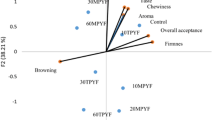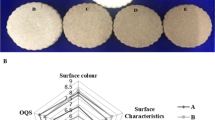Abstract
In this study, chia seed flour (CSF) was used in gluten-free noodle formulation at different levels (0, 10, 20 and 30%, w/w) with and without diacetyl tartaric esters of mono (and di) glycerides (DATEM). Chemical, nutritional, sensory properties and cooking quality of gluten-free noodle samples were investigated. Protein, fat, antioxidant activity and total phenolic content of gluten-free noodles increased by 1.7, 5.5, 2.6 and 2.0 times at 30% usage level of CSF as compared to control sample. Phytic acid and phytate phosphorus content increased from 168.30 mg/100 g and 47.46 mg/100 g to 1057.69 mg/100 g and 298.27 mg/100 g, respectively with CSF usage. Increase of CSF level in gluten-free noodle samples caused an expected increase in the amounts of Ca, P, K, Mg, Fe and Zn. Noodle samples containing CSF showed darker colour than control. Significant increase was observed in volume increase and weight increase values with CSF addition. DATEM reduced cooking loss values of noodle samples. The use of CSF improved the gluten-free noodles taste and odor score. As a result, 20% of CSF with DATEM can be used in gluten-free noodle formulation with acceptable sensory attributes of raw and cooked samples. The present results showed that CSF had a good potential to improve the nutritional quality of noodle.
Similar content being viewed by others
References
AACC (1990) Approved methods of the American Association of Cereal Chemists, 8th edn. AACC, St Paul
Bilgiçli N, Elgün A, Türker S (2006) Effects of various phytase sources on phytic acid content, mineral extractability and protein digestibility of tarhana. Food Chem 98(2):329–337
Bilgiçli N, Demir MK, Ertaş N, Herken EN (2011) Effects of gluten and emulsifier on some properties of erişte prepared with legume flours. Int J Food Sci Nutr 62(1):63–70
Caruso R, Pallone F, Stasi E, Romeo S, Monteleone G (2013) Appropriate nutrient supplementation in celiac disease. Ann Med 45(8):522–531
Coates W, Ayerza R (1996) Production potential of chia in northwestern Argentina. Ind Crops Prod 5(3):229–233
Coelho MS, de las Mercedes Salas-Mellado M (2015) Effects of substituting chia (Salvia hispanica L.) flour or seeds for wheat flour on the quality of the bread. LWT Food Sci Technol 60(2):729–736
Costantini L, Lukšič L, Molinari R, Kreft I, Bonafaccia G, Manzi L, Merendino N (2014) Development of gluten-free bread using tartary buckwheat and chia flour rich in flavonoids and omega-3 fatty acids as ingredients. Food Chem 165:232–240
Cureton P, Fasano A (2009) The increasing incidence of celiac disease and the range of gluten-free products in the marketplace. In: Gallagher E (ed) Gluten-free food science and technology. Wiley, Oxford, pp 1–15
da Silva Pereira B, da Silva Pereira B, dos Santo Cardoso E, Mendonca JOB, de Souza LB, dos Santos MP et al (2013) Physical, chemical and sensory analysis of gluten-free potato bread enriched with chia flour/Analise fisico-quimica e sensorial do pao de batata isento de gluten enriquecido com farinha de chia. Demetra Food Nutr Health 8(2):125–137
Demirci M (2007) Beslenme (Nutrition), 3rd edn. Onur Grafik, Istanbul, p 286. ISBN 9759714642 (In Turkish)
Ding S, Yang J (2013) The influence of emulsifiers on the rheological properties of wheat flour dough and quality of fried instant noodles. LWT Food Sci Technol 53(1):61–69
Francis FJ (1998) Colour analysis. In: Nielsen SS (ed) Food Analysis, Aspen Publishers, New York
Gohara AK, Souza AH, Rodrigues ÂC, Stroher GL, Gomes S, Souza NE et al (2013) Chemometric methods applied to the mineral content increase in chocolate cakes containing chia and azuki. J Braz Chem Soc 24(5):771–776
Haugh W, Lantzsch HJ (1983) Sensitive method for rapid determination of phytate in cereals and cereals products. J Sci Food Agric 34:1423–1426
Houben A, Höchstötter A, Becker T (2012) Possibilities to increase the quality in gluten-free bread production: an overview. Eur Food Res Technol 235(2):195–208
Ixtaina VY, Nolasco SM, Tomas MC (2008) Physical properties of chia (Salvia hispanica L.) seeds. Ind Crops Prod 28(3):286–293
Kaur A, Shevkani K, Singh N, Sharma P, Kaur S (2015) Effect of guar gum and xanthan gum on pasting and noodle-making properties of potato, corn and mung bean starches. J Food Sci Technol 52(12):8113–8121
Kaur A, Shevkani K, Katyal M, Singh N, Ahlawat AK, Singh AM (2016) Physicochemical and rheological properties of starch and flour from different durum wheat varieties and their relationships with noodle quality. J Food Sci Technol 53(4):2127–2138
Kohajdová Z, Karovičová J, Schmidt Š (2009) Significance of emulsifiers and hydrocolloids in bakery industry. Acta Chim Slovaca 2(1):46–61
Kumar V, Sinha AK, Makkar HP, Becker K (2010) Dietary roles of phytate and phytase in human nutrition: a review. Food Chem 120(4):945–959
Lerner A (2010) New therapeutic strategies for celiac disease. Autoimmun Rev 9(3):144–147
Muñoz LA, Cobos A, Diaz O, Aguilera JM (2012) Chia seeds: microstructure, mucilage extraction and hydration. J Food Eng 108(1):216–224
Muñoz LA, Cobos A, Diaz O, Aguilera JM (2013) Chia seed (Salvia hispanica): an ancient grain and a new functional food. Food Rev Int 29(4):394–408
Özkaya B, Özkaya H, Büyükikiz E (2001) The cooking properties of Eriste (Turkish noodle) produced by traditional methods. Getreide Mehl Brot 55(2):120–125
Pizarro PL, Almeida EL, Sammán NC, Chang YK (2013) Evaluation of whole chia (Salvia hispanica L.) flour and hydrogenated vegetable fat in pound cake. LWT Food Sci Technol 54:73–79
Pizarro PL, Almeida EL, Coelho AS, Sammán NC, Hubinger MD, Chang YK (2015) Functional bread with n-3 alpha linolenic acid from whole chia (Salvia hispanica L.) flour. J Food Sci Technol 52(7):4475–4482
Reyes-Caudillo E, Tecante A, Valdivia-López MA (2008) Dietary fibre content and antioxidant activity of phenolic compounds present in Mexican chia (Salvia hispanica L.) seeds. Food Chem 107(2):656–663
Schuppan D, Junker Y, Barisani D (2009) Celiac disease: from pathogenesis to novel therapies. Gastroenterology 137(6):1912–1933
Skujins S (1998) Handbook for ICP—AES (Vartian-Vista), a short guide to vista series ICP—AES operation, Variant Int. AG, Zug, version 1.0, Switzerland
Steffolani E, Hera E, Pérez G, Gómez M (2014) Effect of chia (Salvia hispanica L) addition on the quality of gluten-free bread. J Food Qual 37(5):309–317
Steffolani E, Martinez MM, León AE, Gómez M (2015) Effect of pre-hydration of chia (Salvia hispanica L.), seeds and flour on the quality of wheat flour breads. LWT Food Sci Technol 61(2):401–406
Thompson LU, Zhang L (1991) Phytic acid and minerals: effect on early markers of risk for mammary and colon carcinogenesis. Carcinogenesis 12(11):2041–2045
Tudorica CM, Kuri V, Brennan CS (2002) Nutritional and physicochemical characteristics of dietary fiber enriched pasta. J Agric Food Chem 50:347–356
Ullah R, Nadeem M, Khalique A, Imran M, Mehmood S, Javid A, Hussain J (2016) Nutritional and therapeutic perspectives of chia (Salvia hispanica L.): a review. J Food Sci Technol 53(4):1750–1758
Wronkowska M, Zielińska D, Szawara-Nowak D, Troszyńska A, Soral-Śmietana M (2010) Antioxidative and reducing capacity, macroelements content and sensorial properties of buckwheat-enhanced gluten-free bread. Int J Food Sci Technol 45(10):1993–2000
Yalçın S (2005) A study on production of gluten-free noodles M.Sc. Thesis, Hacettepe University, Ankara, 107 p
Author information
Authors and Affiliations
Corresponding author
Rights and permissions
About this article
Cite this article
Levent, H. Effect of partial substitution of gluten-free flour mixtures with chia (Salvia hispanica L.) flour on quality of gluten-free noodles. J Food Sci Technol 54, 1971–1978 (2017). https://doi.org/10.1007/s13197-017-2633-5
Revised:
Accepted:
Published:
Issue Date:
DOI: https://doi.org/10.1007/s13197-017-2633-5




